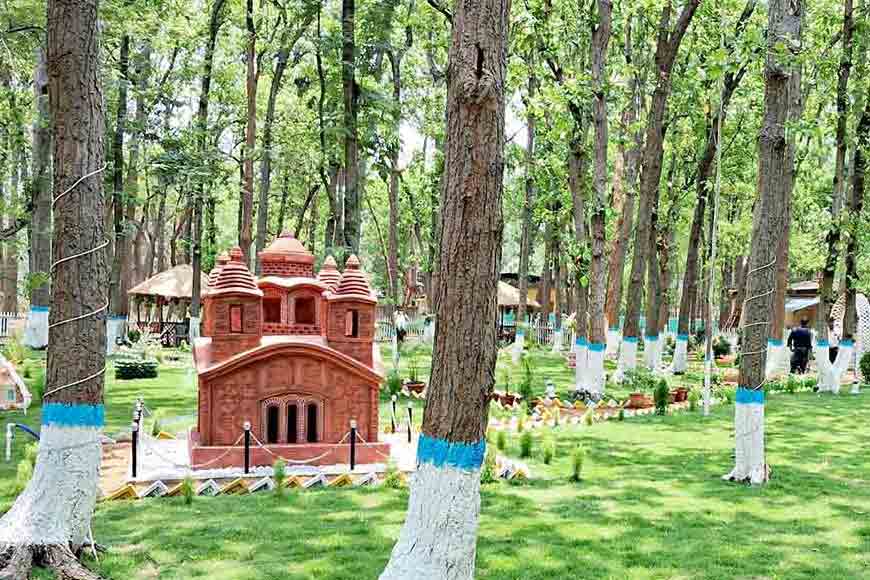Children’s park amid Sal forest built by the Panchet Forest Division

Children's park by Panchet Forest Division in the midst of sal forest in Bishnupur
A five-hour drive from Kolkata leads to a lush forest and a refreshing break from the bleary cityscape. A dense forest teeming with sal, palash, mahua, and neem trees beckons the weary soul. Home to a wide variety of bird species, the dense forest of Bankura is any bag packers' perfect destination. To add to the beauty of the land, the Panchet Forest Division office in Bishnupur took up a project to construct a children’s park around the Sal forest adjacent to the office in Bishnupur. The work is nearing completion.
Set amid nature’s bounty, a verdure grass-carpeted seating area has been made and a replica of the famous Pancha-chura Shyam Rai Temple has been built at the site. The sprawling original temple is located in Bishnupur town and is one of the most beautiful temples in the state. The 17th-century temple was built by King Raghunath Singha, ruler of the mighty Malla dynasty in 1643. This temple probably has the most ornamental decorations all over, with panels depicting scenes from Lord Krishna’s life, ornate floral designs and stories from the Ramayana, Mahabharata, and Puranas. Shyam Rai Temple represents the best of terracotta art. The temple is also called Panch-chura temple because it has five shikhara (pinnacles) on a typical Bengal-style curved Chala roof. It is one of the best examples of the Pancha Ratna architecture style of Bengal. Experiencing the beauty of the exquisite replica of the temple amid the greens is truly a wonderful experience. For contemporary tech fanatics, a ‘Selfie Zone’ has been designated. A large plot has been transformed into a flower garden. The process of planting different types of flowers and foliage plants is currently in progress in the garden. Flower gardens, as we know, serve many purposes. Aside from being visually stunning, the flower garden is being prepared with a view to attracting pollinators, warding off pests, providing shade for sensitive plants, and adding a pleasing, fragrant layer to the area. A butterfly park has been built at one end of the garden.
Also read : Wish to visit a Palash bon? Travel to Bankura
Butterfly Park is the in-situ conservation of butterflies to generate rare species by making available a good habitat to complete their whole life stages within the park. This structure is also known as a lepidopterarium. At a faster rate, our native fauna and flora are disappearing so a garden that attracts butterflies will also bring native bees and birds. They are all really good for the environment and play a role in increasing biodiversity – the variety of plants, animals and micro-organisms and their ecosystems. The authorities plan to encourage tourists, and especially newlyweds, to release butterflies in the garden. This innovative initiative will not only encourage more tourists to visit and participate in the event but it will also help increase the number of butterflies in nature. Bird-friendly small earthen structures have been placed on Sal tree branches for migratory birds to nest. Last-minute work is in progress to spruce up the landscaped garden and once that’s over, it will be opened to the public.
The decision to set up a children’s garden close to the Bishnupur Panchet Forest Division Office was acutely felt as the children of the local Forest Protection Committee officials had no playground amid the forest. The spot has been designed in a manner that allures tourists who can stop here for a short break after a long drive to relieve their stiff bones and then move on to their destination. One of the main objectives of creating this stopover is to link the rich cultural heritage of Bishupur with its natural flora and fauna and introduce visitors to the rich diversity of the land. The project has been launched with an emphasis on forest conservation as well.
The Panchet Forest Division (PFD) was previously known as the Panchet Soil Conservation Division. It was established on 1 April 1966. The objective behind the formation of this department was mainly to do soil conservation projects in the upper Damodar catchments. The name was derived from the base name ‘Panchet’, a place where the Damodar River originates in the Dhanbad district now in the state of Jharkhand. Initially, PFD's headquarter was situated in Purulia district. In 1982, it was shifted to Bishnupur of Bankura district to control the flood and soil erosion of the Rupnarayan–Ajay catchment area, which comes under Bankura, Burdwan and Birbhum districts.
Several afforestation projects, including water harvesting schemes and the construction of check dams, were undertaken to control soil erosion. In 1995, this division was reorganized and converted into a territorial division incorporating the eastern portion of Bankura district. From November 1995, the Panchet Soil Conservation Division was excluded from the soil conservation circle and included under the Central Circle of Forest, West Bengal, and re-named as Panchet Forest Division.
According to PFD officials, once the park is ready and opened to the public, local artisans will be allotted temporary space to congregate and sell handicraft items every Saturday. Cultural programmes will also be held regularly where government-sponsored artists will perform.











